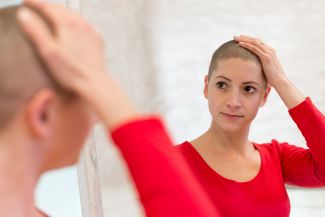How Does One Grow Back Their Hair After Chemo
Can Hair Grow Back After Chemo?
Image

As you grow, most of your cells are constantly dividing through a process called cell multiplication.
When you become an adult, this occurs less frequently, only when your body needs to repair itself. However, some normal cells continue to multiply quickly, including those that must constantly grow or renew themselves, such as bone marrow, skin, the lining of the digestive tract, and hair follicles.
Chemotherapy (chemo) drugs identify and target cells that reproduce quickly, regardless of whether they are cancerous or not. This is why chemo causes side effects such as hair loss. Because some types of chemo attack not only cancer cells but also cells that multiply quickly, those drugs are more likely to cause hair loss.
Never miss another Cancer Talk blog!
Sign up to receive our monthly Cancer Talk e-newsletter.
Sign up!
If you are receiving a chemo that is likely to damage hair follicles (the root of the hair), hair loss usually begins about 2 weeks after treatment begins. Hair loss can range from thinning of the hair on your head to loss of all body hair. Damage to these normal cells is usually temporary. Chemo-induced hair loss may be reduced by stopping or slowing the absorption of these drugs into the hair follicles. Once chemo has ended and the follicles are repaired, the hair begins to grow back. Sometimes the new hair is quite different from the original hair in texture or color. It may even be more or less curly.
Did you know?
Hair grows in cycles. Approximately 80-90% of the time, hairs are in the growing phase. The cells are multiplying quickly, and the hair is growing about 0.3 millimeters a day (1/2 inch per month). These growth cycles occur faster on the scalp, so the hair on your head grows faster than your body hair. On average, we have about 100,000 hairs on our head, and about 100 of them fall out every day.
Chemo and Hair Loss: What You Need to Know
- Not all chemo drugs cause hair loss.
- Hair loss can be fast or slow.
- You may lose all or just some of your hair.
- Your hair may fall out in clumps or thin out.
- If you have total hair loss, you will lose your eyelashes, eyebrows, and armpit and pubic hair.
- Hair loss may begin 2-3 weeks after your first chemo treatment, or it may not begin until after your second cycle.
- Hair may start growing back while you are still in treatment or 3-6 months after you have completed chemo.
- The extent of hair loss may depend on a number of factors, such as the chemo drug being used, the dose, how it is given and how frequently it is given. For example, high-dose or intravenous chemo is more likely than low-dose or oral chemo to result total hair loss, and combination chemo regimens (particularly ones that include doxorubicin, docetaxel, paclitaxel or etoposide) are more likely to cause hair loss than single-drug chemo.
Although many chemo drugs cause hair loss, this side effect is usually temporary. Once treatment has stopped, your hair will begin to grow back. Talk to your doctor about steps you can take to minimize hair loss during chemo, such as wearing a cooling cap or avoiding hair products with bleach, menthol, gelatin or alcohol.
How Does One Grow Back Their Hair After Chemo
Source: https://www.roswellpark.org/cancertalk/201807/can-hair-grow-back-after-chemo#:~:text=Chemo%2Dinduced%20hair%20loss%20may,be%20more%20or%20less%20curly.
0 Response to "How Does One Grow Back Their Hair After Chemo"
Post a Comment